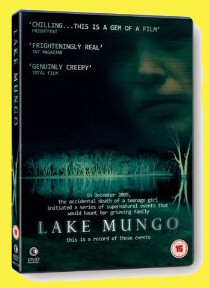
Talk of a young girl ‘keeping secrets’ followed by footage of people looking for her ushers in the understated but accomplished supernatural mockumentary horror of Lake Mungo (2008), a film which deftly progresses through a series of intrigues and surprises. The quality of this film belies its evident low budget, and it was a pleasure to encounter such a genuinely creepy movie which avoided the pitfalls of so many comparable contemporary efforts.
In December 2005 in the small town of Ararat in Victoria, Australia, sixteen year old Alice disappears after swimming in a nearby creek with her brother. Although local police and rescue teams search for her, her body is soon afterwards found and identified – propelling her family into grief. However, there seems to be one uniting factor between them, regardless of the different ways in which they’re handling their feelings. This is through the family’s increasing sense of supernatural phenomena in their home – strange noises, disturbing dreams, and even what appear to be images of Alice in recent photographs. Mum June (Rosie Traynor) struggles particularly with all of this, turning to a psychic called Ray (Steve Jodrell) for support. Yet, the apparent presence of Alice on film and in photos is not straightforward: as this footage is examined, mysteries about Alice come to light and must be understood if her relatives are ever to make sense of what happened to her.
Lake Mungo comes across as a confident film, although it knows its limitations: it takes chances, seeming to show its hand early on and then backtracking from that point to offer something different – not to the extent that this is completely unlike anything which has come before it, but it is bold enough to explore its genre. It includes elements of supernatural horror which are very familiar – such as the almost obligatory involvement of a psychic who has ‘never experienced phenomena of such severity’ – but it avoids histrionics and flashiness, going instead for characters which you can believe have a life beyond the plot. This allows genuine concern for them, as well as meaning the audience have something invested in the intrigue which follows. The fact that the film’s supernatural phenomena are so often recounted verbally, rather than flung at us loaded with jump-cuts and effects, makes it all feel far more like an old-fashioned ghost story. It’s gripping, rather than gratuitous. As the film uses the mockumentary format, it can legitimately edit together lots of different kinds of footage (the blurriness of some of which also works towards the suggestion of scares) and also builds pace which is lacking in the Paranormal Activities of this world: Lake Mungo is intended to look like a real film, after all. The pace isn’t perfect, granted, but just when it begins to lag the plot generates something else which holds attention. It’s an intriguing story. It’s also bleak to the very end with the same quiet style it displays throughout (that is, with the exception of one scene which jars brilliantly with the rest of the film and made me jump out of my skin).
At its heart, Lake Mungo builds a sad, often scary story around an absent person – someone we only see refracted through other people’s accounts or their footage, but always partly present and reaching out through a godless mish-mash of dreams, séances and modern media. I was impressed and surprised by this film and I feel encouraged that you don’t need a flashy budget to create a decent, creepy yarn (nor is it an excuse to pass off any old thing into which you can crowbar grainy footage – there’s so much more to a ghost story than that). There’s a remake coming our way, apparently, and one that will more than likely beef up all the elements which make Lake Mungo effective for me: the new poster looks like a real warning to the curious. Of course, if you like your horror louder and meaner then you may prefer this approach.
Colour and sound are well-presented here, allowing for the fact that there are lots of different video formats where contrast and colour obviously vary. The incidental sound effects here are great and fit very well. Lake Mungo is presented in a 16:9 ratio, with the usual digital/stereo sound options available and, not overstaying its welcome whatsoever, it runs for 87 minutes.
Review by Keri O’Shea
| Released by Second Sight Films |
| Region 2 - PAL |
| Rated 18 |
| Extras : |
| see main review |